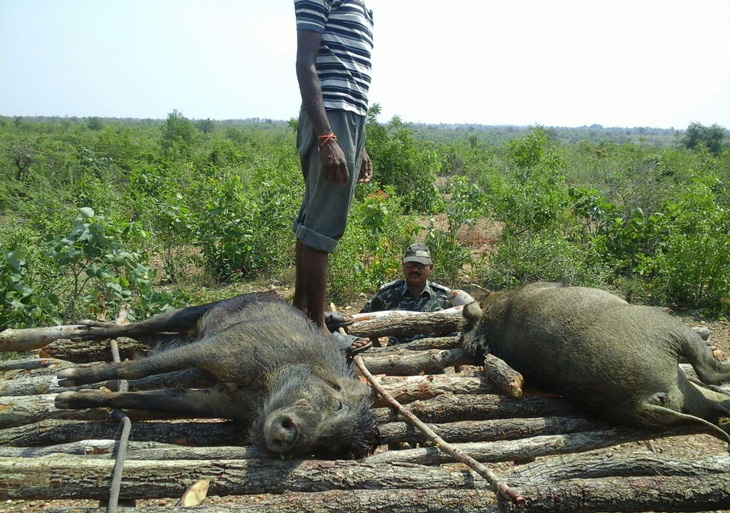Shocking! Maharashtra forest department culls 300 wild boars, nil gais

Chandrapur district of Maharashtra is the tiger capital of India. With tiger habitats such as Tadoba Andhari Tiger Reserve on the outskirts and thick forest cover across the district, Chandrapur is home to more than 100 tigers and 300 leopards. And with one of the highest forest and wildlife density, Chandrapur district frequently experiences man-animal conflicts. Sometimes it is wild cats crossing the road, other times it is herbivorous raiding standing crop.
Man-animal conflict is not new for Chandrapur district. But it is the wildlife has been at the receiving end every time. They are always either culled or relocated.
Most recently, following several complaints of crop raids by wild boars and blue bulls (Neel Gai), the local forest department has culled a whooping 300 animals in the past few months.
Also read - Why is Australia killing almost 2000 kangaroos?
This year, wild boars and blue bull menace was first reported from the district in early January. Several farmers reported huge losses due to crop raids. When the frequency of raids increased, people started demanding culling. When the pressure mounted, the state forest department issued a GR allowing culling of wild boars and blue bulls.
While on the one hand, forest department claims that the decision was taken based on complaints from the villagers, on the other hand environmentalist feel that the department is arbitrarily killing the animals. Interestingly, professional hunters from Andhra Pradesh are being called to do the job.
The forest department is conspicuously silent about relocating these animals to forests with smaller prey base for carnivores. A senior forest department official who wishes to remain anonymous says, "There is no option but to cull the problem animals. Otherwise, unrest among people will rise and result in killing of other animals, which is an even bigger problem for the wildlife."

When asked about exploring the option of relocating these animals to other forests, the official rejected the option saying that it was not logistically possible for the department to relocate the animals since they did not have the expertise to capture the animals.
Suresh Chopne, a wildlife activist from Chandrapur and a member of the state wildlife board, who has been spearheading the anti-culling movement, has lodged several complaints and held many meetings with the forest department officials to convince them to explore other options. "Our complaints are falling on deaf ears. All my letters and complaints seem to have ended in the dustbin. Whenever we try to discuss relocating the animals, officials simply refuse to even consider it. We are now planning to launch a public movement to stop the culling," Chopne says.
Nitin Desai, the central India director of the Wildlife Protection Society of India (WPSI) says, "This is a mindless decision. One can understand controlled culling can be an option. But arbitrary killing of wild boars in Chandrapur district is bound to have drastic impact on the animals. One has to be very careful about choosing the animals for killing."
According to Desai, these animals could have been easily relocated to other tiger habitats such as the Melghat tiger reserve or the Pench reserve.
Ridiculing the claims about logistic problems to relocate the animals, Desai says, "Wild boars are so agile they can easily be relocated to other forests. Forest department should consider relocating the animals to Melghat tiger reserve, where there is an acute shortage of prey base for tigers and leopards." He said that a recent analysis conducted at Melghat Tiger Reserve has revealed that the insects formed a considerable chunk of tiger prey.
"This is the ideal area for relocating the wild boars. They will not only survive, but also thrive once released in Melghat Tiger Reserve," Desai said. The Chief Conservator of Forest, Chandrapur SP Thakre could not be reached for his version.
More in Catch - Is culling the solution to Shimla's monkey business?
Delhi's dog menace: Blame the civic bodies, not the strays
First published: 16 May 2016, 8:38 IST




![BJP's Kapil Mishra recreates Shankar Mahadevan’s ‘Breathless’ song to highlight Delhi pollution [WATCH] BJP's Kapil Mishra recreates Shankar Mahadevan’s ‘Breathless’ song to highlight Delhi pollution [WATCH]](https://images.catchnews.com/upload/2022/11/03/kapil-mishra_240884_300x172.png)

![Anupam Kher shares pictures of his toned body on 67th birthday [MUST SEE] Anupam Kher shares pictures of his toned body on 67th birthday [MUST SEE]](https://images.catchnews.com/upload/2022/03/07/Anupam_kher_231145_300x172.jpg)






